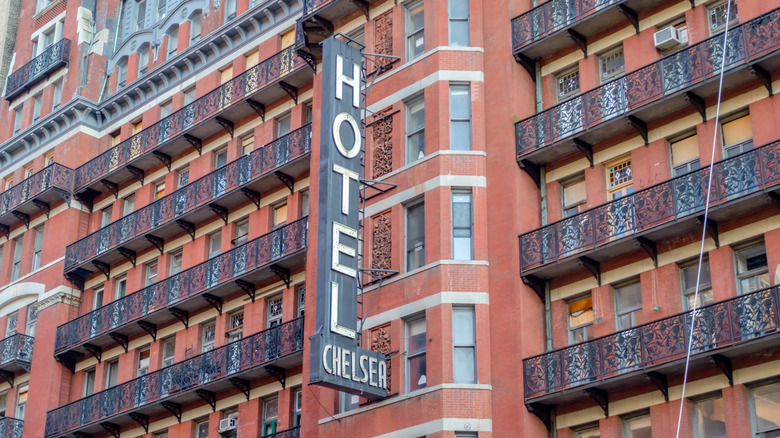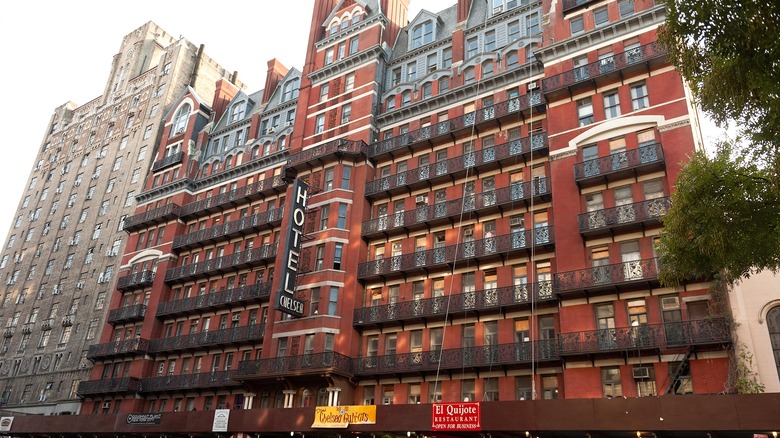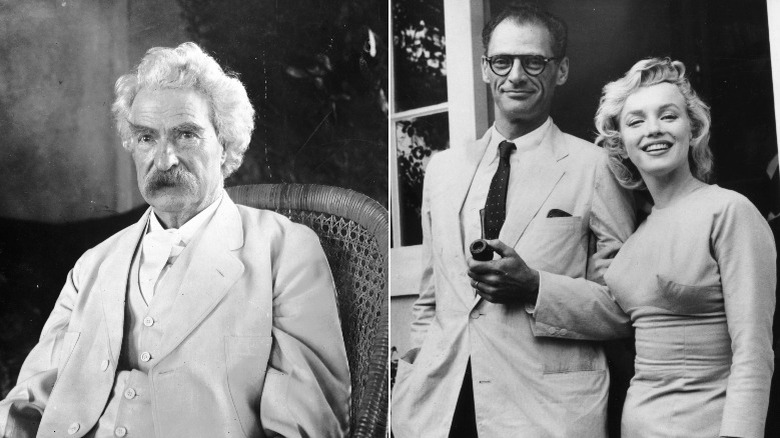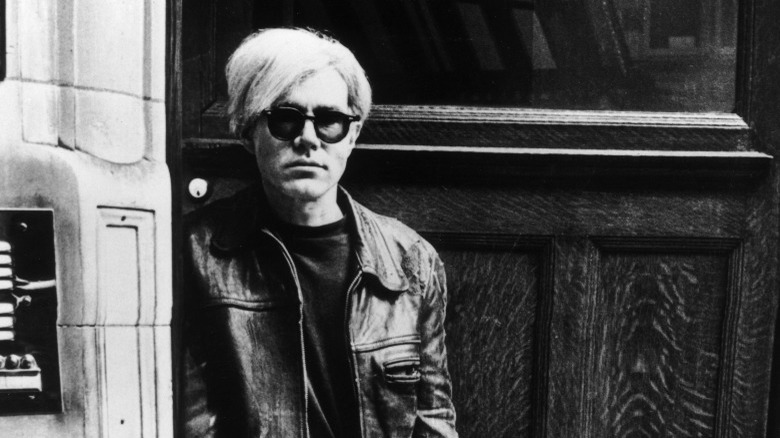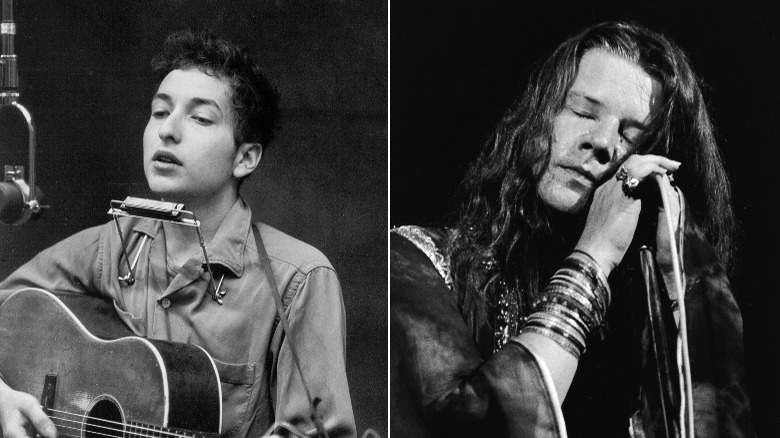The Hotel That Played A Huge Role In The New York City Modern Art Scene
New York City is full of landmarks. Some, like the Statue of Liberty, are symbolic and represent American values, while others are tied to specific moments or events in time. In a way, the Chelsea Hotel checks both of those boxes. It's a building through which some of the greatest artistic minds of several generations passed at one point or another during their lifetime, effectively painting the building itself as a beacon symbol for creative and artistic exploration, innovation, and freedom.
The Chelsea Hotel has hosted — sometimes for a short time, sometimes for years — some of the most important writers, artists, actors, musicians, and filmmakers in history. Everyone who spent time at the Chelsea Hotel, from Mark Twain to Bob Dylan, from Joan Baez to Andy Warhol, has had a hand in making the Chelsea Hotel one of the most significant buildings in the history of American pop culture (via Vanity Fair).
The early days of the Chelsea Hotel
According to the City University of New York, New York City's Chelsea neighborhood is one of the oldest in the city to still go by its original name. The piece of land that became the neighborhood was purchased in 1750 by an Englishman named Thomas Clarke. He bought a ten-square block parcel of land near the water and named it Chelsea. However, it wasn't until about eighty years later that his grandson Clement Clarke Moore — who is probably best remembered for having written the poem, "The Night Before Christmas" — divided up his grandfather's estate.
The building that became the Chelsea Hotel was built around fifty years later. It opened in 1884, in what was then part of the city's theater district. According to Britannica, the building was constructed to serve as one of the city's first co-op apartment complexes, and for a very brief time after its completion, it held the distinction of being the tallest building in New York City.
The Chelsea Hotel only became a hotel in 1905, after the co-op apartment went belly up. The switch to a luxury hotel ushered in the Chelsea Hotels' reputation for hosting some of history's greatest creative minds.
The writers move in
Upon its shift to a luxury hotel, the Chelsea Hotel started drawing artists and writers. These were established names looking for a place to kick back while in New York City, as opposed to the veritable artists' colony it became in the decades that followed. One of America's most iconic writers — Mark Twain — stayed at the hotel in the early 20th century. According to Britannica, he could be seen strolling through the hallways, while others preferred to stick to their rooms, either as an artistic refuge or possibly as a way of dodging debt collectors. O. Henry, best known for short stories like "The Gift of the Magi" and "The Duplicity of Hargraves," was known to use a series of fake names while staying at the hotel to stay under his creditors' radar.
Writers continued to frequent the hotel and some iconic works were written there. Arthur C. Clarke wrote his 1968 science fiction novel, "2001: A Space Odyssey," while staying at the Chelsea. Coincidentally, Stanley Kubrick, who directed the film adaptation of the novel, was also a former resident of the hotel. According to Vanity Fair, other writers that spent time there included Jack Kerouac, William S. Burroughs, and playwright/Marilyn Monroe's husband Arthur Miller.
The hotel hosted many of the biggest names in modern art
Painters were also moving into the building in the early 1900s, including Childe Hassam and John Sloan, per Britannica. However, they brought their established artistic styles and sensibilities to the Chelsea Hotel, while the generations of artists that followed would develop their own inside the hotel. Of all the artists that migrated through Chelsea Hotel and left their mark on the building, members of the modern art scene are perhaps the best known.
Jackson Pollock, known for his paintings that used his trademark drip technique stayed at the hotel, and left his mark, and not just figuratively. According to E News, during a luncheon hosted by art collector Peggy Guggenheim, Pollock vomited on the floor of the hotel dining room. Guggenheim's sister had the restaurant manager cut out the soiled carpet — which probably looked conspicuously like one of Pollock's paintings — and framed it.
One of the most iconic names of the modern art movement, Andy Warhol, also spent time at the hotel, He produced a 1966 film called "Chelsea Girls" that was shot at the Chelsea Hotel. However, the movie was sometimes accused of painting the hotel in a negative way and taking away some of its mystique. Whether that was true or not had no bearing on the creative output of the hotel's residents.
Musicians at the Chelsea Hotel
Artists of all kinds flocked to the Chelsea Hotel and musicians were no exception. Janis Joplin, Bob Dylan, Leonard Cohen, and Jimi Hendrix all spent time at the hotel and wrote songs in the hotel — sometimes even about the hotel (via Vanity Fair). According to Britannica, Arthur Miller noted that in the '60s, many of the hotel's residents "stumbled into the Chelsea with young, bloodshot eyes," a reference to the growing drug culture inside the hotel. Rolling Stones guitarist Keith Richards was known to frequent the hotel and was quoted as saying "You had to be a certified dealer to get a job as a bellboy." Coincidentally, Jimi Hendrix was mistaken for a luggage porter by an elderly woman.
However, one of the darkest moments in the hotel's history is tied to musicians, specifically Sid Vicious, bassist for the pioneering punk band the Sex Pistols. According to Rolling Stone, Nancy Spungen was 17 years old when she dropped out of college, moved to New York City, and threw herself into the punk scene. She met Vicious on a trip to London in 1977 and the two became a couple.
In 1978, Spungen was found dead from a stab wound on the bathroom floor of her room at the Chelsea Hotel. Vicious was charged with murdering her, however, before he could go to trial he died from a drug overdose.
